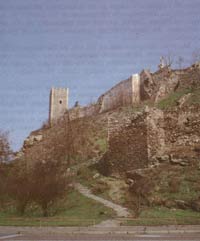Fortress Kale
Previous | Home | Next
Fortress KalePrevious | Home | Next |
 |
| Partial
archaeological excavations in the past demonstrate that the first buildings,
earthen dwellings and huts, which marked the beginning of life in a larger
pre-historic settlement, appeared at the Skopje Kale during the transition
from Neolithic to Bronze Age.
Research has uncovered remains of an older fortress under the foundations of the existing Kale, built in the Middle Ages. It is believed to have been built between the Bronze Age and the Iron Age. Another hypothesis is that it came into being during the preparation period of the Dardanians for defending this territory from the aspirations of Rome. It is a fact, though, that there was a disastrous earthquake in 518 AD which, according to reports by chronicler Komes Marzelinus, destroyed 24 fortified urban areas, the ancient city of Skupi being one of them. Since the Kale was only about five kilometres away from this ancient city, we imagine that the buildings located at the Kale at that time must have been damaged or destroyed too. After the earthquake, the Kale was again chosen as the foundation for the new city. Latest explorations have shown that this Middle Ages fortress was built during the reign of the Macedonian tsar Samoil, i.e. in the end of the 10th and the beginning of the 11th century, and became an important fortification against the Romaoian onslaughts.
What has remained today is an impressive 121-metre-long remnant of the rampart that once was, built with processed stone blocks. It has been proved that this building material had been brought from the ruins of the destroyed theatre of the ancient city of Skupi. Throughout its centuries long existence in one of the key strategic positions in this part of the Balkans, the Fortress was often attacked, besieged, destroyed, and restored. With the invention of fire arms later on, there were gradual efforts to adjust the fortress to these new circumstances of warfare by building loopholes and cannon platforms. A more detailed description of the Kale was rendered by the famous Turkish travel writers Evlija Celebija who visited the Fortress in 1660/61. Here is what he wrote: "That is a fortified city, a strong and solid fortification with double ramparts. The city gate and the ramparts are built with carved stone which shines like polished. Such refinement and artistry cannot be seen in any other city." Travel writers who visited the Kale in the 19th century reveal that the Fortress accommodated ammunition depots and gunpowder plants, a military hospital and a prison. The Fortress was heavily damaged in the earthquake of 1963 and restored afterwards. |
||
 |
||